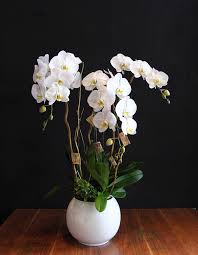# The Integration of Phalaenopsis Orchids and Modern Technology in Agriculture

The world of agriculture is rapidly evolving, with technology playing a crucial role in enhancing productivity, sustainability, and efficiency. Among the many plants cultivated in modern agriculture, Phalaenopsis orchids—commonly known as moth orchids—stand out for their beauty and commercial value. This article explores the integration of Phalaenopsis orchids with modern agricultural technologies, discussing innovations that improve cultivation, propagation, and marketability.
## Table of Contents
1. **Introduction to Phalaenopsis Orchids**
– 1.1 Overview of Phalaenopsis Orchids
– 1.2 Economic Importance of Phalaenopsis Orchids
2. **The Role of Technology in Modern Agriculture**
– 2.1 Definition and Scope of Agricultural Technology
– 2.2 Benefits of Technology in Agriculture
3. **Smart Greenhouses for Phalaenopsis Orchids**
– 3.1 Features of Smart Greenhouses
– 3.2 Benefits for Orchid Cultivation
4. **Hydroponics and Phalaenopsis Orchids**
– 4.1 Understanding Hydroponics
– 4.2 Advantages of Hydroponic Systems for Orchids
5. **Precision Agriculture Techniques**
– 5.1 What is Precision Agriculture?
– 5.2 Application of Precision Techniques in Orchid Farming
6. **Genetic Engineering and Hybridization**
– 6.1 The Science of Genetic Modification
– 6.2 Creating New Phalaenopsis Varieties
7. **Use of Drones in Orchid Cultivation**
– 7.1 Benefits of Drones in Agriculture
– 7.2 Applications for Phalaenopsis Orchids
8. **Data Management and IoT in Orchid Farming**
– 8.1 Introduction to IoT in Agriculture
– 8.2 Utilizing Data for Improved Cultivation Practices
9. **Sustainability and Eco-Friendly Practices**
– 9.1 Importance of Sustainable Practices
– 9.2 How Technology Aids Sustainability in Orchid Farming
10. **Future Trends and Innovations in Orchid Cultivation**
– 10.1 Emerging Technologies
– 10.2 The Future of Phalaenopsis Orchids in Agriculture
—
## 1. Introduction to Phalaenopsis Orchids
### 1.1 Overview of Phalaenopsis Orchids
Phalaenopsis orchids are native to Southeast Asia and are among the most popular orchids due to their stunning blooms and ease of care. With a wide variety of colors and patterns, these orchids are prized by both hobbyists and commercial growers. Their long-lasting flowers and adaptability to different growing conditions make them an ideal choice for florists and nurseries.
### 1.2 Economic Importance of Phalaenopsis Orchids
The global orchid market is worth billions of dollars, with Phalaenopsis orchids constituting a significant portion of this market. They are widely cultivated for their aesthetic appeal, and their demand continues to grow in various sectors, including floristry, landscaping, and interior design. The integration of technology into orchid farming not only enhances the quality of these plants but also boosts profitability for growers.
## 2. The Role of Technology in Modern Agriculture
### 2.1 Definition and Scope of Agricultural Technology
Agricultural technology encompasses a broad range of tools, techniques, and systems designed to enhance the efficiency and productivity of agricultural practices. This includes advancements in machinery, biotechnology, data management, and sustainable practices. The goal of agricultural technology is to improve crop yield, reduce labor costs, and minimize environmental impact.
### 2.2 Benefits of Technology in Agriculture
The adoption of technology in agriculture offers numerous benefits:
– **Increased Efficiency**: Automation and precision farming techniques streamline processes, reducing labor and resource costs.
– **Improved Crop Quality**: Advanced monitoring and management systems enable growers to maintain optimal conditions for plant health.
– **Sustainability**: Technological innovations promote eco-friendly practices, minimizing waste and environmental harm.
## 3. Smart Greenhouses for Phalaenopsis Orchids
### 3.1 Features of Smart Greenhouses
Smart greenhouses incorporate technology such as sensors, automation, and climate control systems to create optimal growing conditions for plants. Key features include:
– **Automated Climate Control**: Systems that adjust temperature, humidity, and light levels based on real-time data.
– **Soil and Nutrient Monitoring**: Sensors that monitor soil moisture, pH, and nutrient levels, ensuring plants receive the proper care.
– **Remote Monitoring**: Growers can track conditions and make adjustments remotely through mobile apps or web interfaces.
### 3.2 Benefits for Orchid Cultivation
Smart greenhouses provide numerous advantages for Phalaenopsis orchid cultivation:
– **Enhanced Growth Conditions**: Optimized climate and nutrient management lead to healthier plants and more vibrant blooms.
– **Reduced Resource Use**: Automated systems minimize water and fertilizer waste, contributing to sustainable practices.
– **Increased Yield**: By maintaining ideal conditions, growers can achieve higher yields and better quality flowers.
## 4. Hydroponics and Phalaenopsis Orchids
### 4.1 Understanding Hydroponics
Hydroponics is a method of growing plants without soil, using nutrient-rich water solutions instead. This technique allows for precise control over growing conditions, including nutrient availability and water usage.
### 4.2 Advantages of Hydroponic Systems for Orchids
Hydroponic systems offer several benefits for growing Phalaenopsis orchids:
– **Faster Growth Rates**: Without soil, plants can access nutrients more efficiently, leading to faster growth.
– **Space Efficiency**: Hydroponics allows for vertical farming and optimized space utilization, making it ideal for urban environments.
– **Pest and Disease Management**: Reduced soil contact decreases the risk of soil-borne pests and diseases.
## 5. Precision Agriculture Techniques
### 5.1 What is Precision Agriculture?
Precision agriculture involves using technology to monitor and manage crop production on a site-specific basis. This approach enables farmers to apply resources more efficiently, improving yields while minimizing waste.
### 5.2 Application of Precision Techniques in Orchid Farming
In Phalaenopsis orchid farming, precision agriculture can be applied through:
– **Soil Mapping**: Identifying variations in soil properties allows for tailored nutrient applications.
– **Remote Sensing**: Utilizing satellite or drone imagery to monitor plant health and growth patterns.
– **Variable Rate Technology**: Adjusting water and fertilizer application rates based on real-time data, ensuring optimal resource use.
## 6. Genetic Engineering and Hybridization
### 6.1 The Science of Genetic Modification
Genetic engineering involves altering the genetic makeup of organisms to achieve desired traits. This can include enhancing flower color, improving disease resistance, or increasing flower longevity.
### 6.2 Creating New Phalaenopsis Varieties
Through genetic engineering and hybridization, researchers and growers can develop new Phalaenopsis orchid varieties with unique characteristics:
– **Color Variations**: Genetic modifications can lead to orchids with novel colors and patterns, expanding market appeal.
– **Disease Resistance**: Engineering resistance to common orchid diseases can reduce reliance on chemical treatments.
– **Improved Longevity**: Creating hybrids with longer-lasting blooms enhances their commercial value.
## 7. Use of Drones in Orchid Cultivation
### 7.1 Benefits of Drones in Agriculture
Drones have become invaluable tools in modern agriculture, offering numerous benefits:
– **Aerial Monitoring**: Drones can capture high-resolution images of crops, allowing for detailed assessments of plant health and growth patterns.
– **Precision Application**: Drones can deliver fertilizers, pesticides, and other inputs with high accuracy, reducing waste and environmental impact.
– **Data Collection**: Drones can collect valuable data for analysis, improving decision-making processes.
### 7.2 Applications for Phalaenopsis Orchids
In Phalaenopsis orchid cultivation, drones can be utilized for:
– **Crop Monitoring**: Regular aerial inspections help identify issues such as pests, diseases, and nutrient deficiencies.
– **Mapping and Planning**: Drones can create detailed maps of orchid farms, aiding in planning and management.
## 8. Data Management and IoT in Orchid Farming
### 8.1 Introduction to IoT in Agriculture
The Internet of Things (IoT) refers to the network of interconnected devices that communicate and share data. In agriculture, IoT applications include sensors, smart devices, and data analytics platforms that enhance farming practices.
### 8.2 Utilizing Data for Improved Cultivation Practices
In Phalaenopsis orchid farming, IoT technology can be leveraged for:
– **Real-Time Monitoring**: Sensors can continuously track environmental conditions, enabling timely adjustments for optimal growth.
– **Data Analytics**: Analyzing data from multiple sources can inform better decision-making regarding irrigation, fertilization, and pest management.
– **Predictive Maintenance**: IoT can help predict equipment failures, allowing for proactive maintenance and reducing downtime.
## 9. Sustainability and Eco-Friendly Practices
### 9.1 Importance of Sustainable Practices
Sustainable agriculture focuses on meeting the needs of the present without compromising future generations. This includes conserving resources, protecting ecosystems, and promoting biodiversity.
### 9.2 How Technology Aids Sustainability in Orchid Farming
Technology plays a pivotal role in promoting sustainability in Phalaenopsis orchid cultivation:
– **Water Conservation**: Automated irrigation systems minimize water waste, ensuring efficient use of this vital resource.
– **Integrated Pest Management**: Technology enables better monitoring and management of pests, reducing the need for chemical treatments.
– **Energy Efficiency**: Smart greenhouses and climate control systems optimize energy use, lowering the carbon footprint of orchid farming.
## 10. Future Trends and Innovations in Orchid Cultivation
### 10.1 Emerging Technologies
As technology continues
to advance, new innovations are likely to emerge in the field of orchid cultivation:
– **Artificial Intelligence**: AI can analyze large datasets to provide insights into plant health, growth patterns, and optimal care strategies.
– **Vertical Farming**: Innovations in vertical farming technology can enable year-round production of Phalaenopsis orchids, maximizing space and resources.
### 10.2 The Future of Phalaenopsis Orchids in Agriculture
The future of Phalaenopsis orchids in agriculture looks promising, with technology paving the way for increased efficiency, sustainability, and market growth. By integrating modern agricultural practices, growers can continue to enhance the beauty and commercial viability of these stunning plants.
—
In conclusion, the integration of Phalaenopsis orchids and modern technology in agriculture presents a unique opportunity for growers to improve their practices, enhance sustainability, and increase profitability. As innovations continue to evolve, the future of orchid cultivation will be marked by a commitment to quality, efficiency, and environmental stewardship. By embracing these advancements, growers can ensure that Phalaenopsis orchids remain a beloved choice for consumers around the world.

